Behind the Garden Gate
Supports, compost, watering cans, and the unglamorous graft that keeps the garden loved and the flowers fabulous.
Hello my fellow flower fanatics. Today, I’m drawing back the dusty curtain to share with you the goings on behind the polished photos. Out there, the borders might look dreamy, the pots lush, and the veg plot bountiful, but none of that happens without the slightly less glamorous work that goes on backstage, behind the camera.
Think of this as a little wander through the garden gate, a sneaky peek over the fence, at the jobs that usually happen when no one’s looking. It’s not all mud and sweat (though there’s plenty of that too), but the quiet, everyday graft that makes the show sparkle. And since you’re here, cup of tea in hand, let me show you how it all works…
(Note: Annoyingly, the end of this may be cut short by certain email apps)
A Typical Summer’s Morning
Deadheading is usually the first order of the day. Strolling along the borders, trug and snips in hand, pruning off faded blooms. Easy yet satisfying. Minimal effort but a good one to tick off the to-do list (for a brief but welcome hit of accomplishment - essential when my mood is less than buoyant).
It’s a good opportunity to take in the garden too, spotting weeds or struggling plants, ones that need supporting, or a little extra water. All mental notes for later, or quickly tapped into my Reminders app.
When I’m done, I’ll pop on the irrigation system to give the specimen Japanese maples a morning drink, then it’s round to the Kitchen Garden to harvest courgettes, tomatoes, sweetcorn, cucumbers, cut flowers and herbs for the day.
There’s always a ball of twine round there for tying in tomatoes and cucumbers, and canes for the sweetcorn that might be a little wayward. I’ll prune any mouldy cucurbit leaves, spent tomato trusses and side-shoots while I’m there.
All the deadheading and prunings are taken to the compost bays, along with the previous night’s prunings or kitchen scraps. It’s great to keep the heap well fuelled and humming along. Then it’s back round to turn off the irrigation and get down to some writing or photography.
Along with a spot of weeding and popping in the odd cane, it’s a little and often approach. The majority of the supports are in by May. Summer is a time of watering, feeding, deadheading, composting, and keeping the show going. Now, let’s dive into those juicy details.
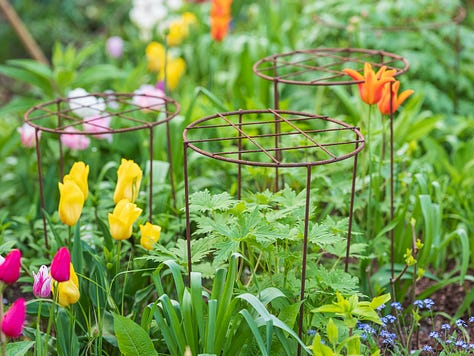
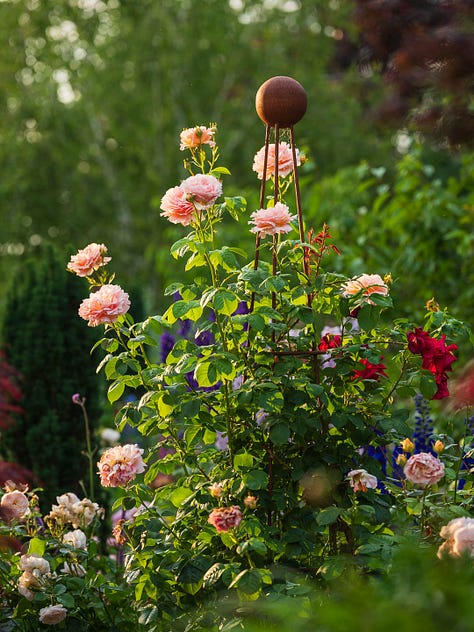
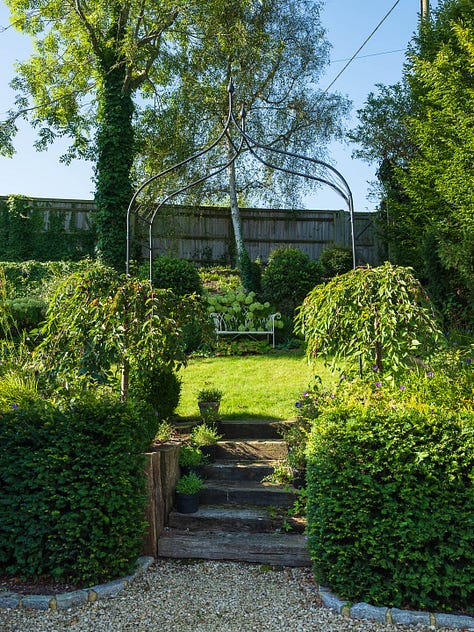
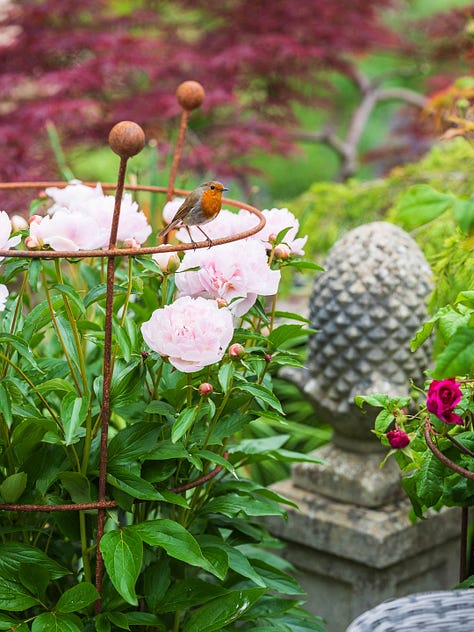
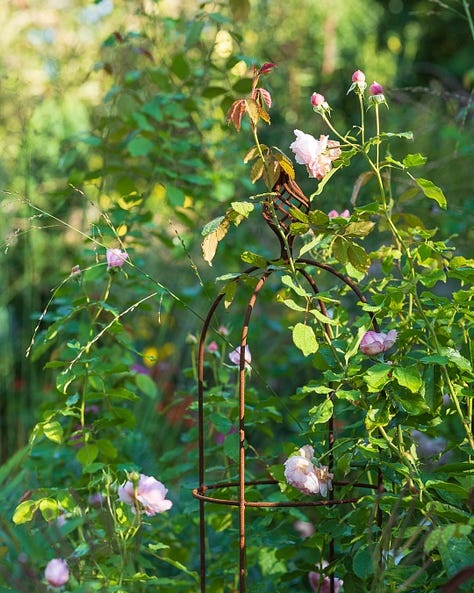

Holding It Together: Supports Big and Small
Border plants are wonderful, but let’s be honest, half of them can’t stand up without a bit of help, especially when you have monsters like: Delphinium ‘Faust’, Cephalaria gigantea, Rudbeckia laciniata, Persicaria amplexicaulis, Helianthus ‘Sheila’s Sunshine’, not to mention the climbing and rambling roses.
Some giants are self-supporting, like Althaea cannabina, or are happy to lean on each other when the planting is just right. But without props, many tall plants can flop, sulk, or faint at the slightest breeze. That’s where the supports come in.
Some supports are rather elegant, even glamorous: the Gothic Arch that carries roses skyward in the Cottage Garden, the towering rustic obelisks that punctuate the Flower Garden, crowned with great rusty balls, or the sage green inverted obelisk carrying a pure white clematis.
Others are purely functional or temporary fixes… The peony frames that vanish beneath glossy foliage. A bamboo cane (or three placed in a triangle) with a loop of twine for when a delphinium keels over. Like good underwear… you don’t see it, but it keeps everything in place.
Tip: I always cut the canes down so they’re not visible and distracting.
I’m a big fan of quality 3-ply twine. There’s always a roll nearby. On a shelf in the potting shed. Tucked into the side of the wood store. One on the rack in the garage. And one in the porch that never seems to find a permanent home.
Twine is the gardener’s duct tape, gently holding the whole world together one fluffy knot at a time. It has a certain amount of natural give, allowing stems to expand without cutting-in. It’s biodegradable too, so you can drop old bits on the ground (I’ve seen birds use it as nesting material) or throw it on the compost heap at the end of the season. I do not use plastic ties or rubber coated wire.
The roses clambering over walls and fences are tied into place (yes, with more twine), supported with lines of galvanised wire rope spaced roughly 30cm apart, with hooks, eyes, and turnbuckles to keep the tension nice and taut. After the summer flush of blooms, I’ll tie in the new growth while it’s green and bendy.
I like the balance of all these supports: structures handsome enough to be features in their own right, alongside the scrappy fixes that just do the job but stay out of sight. Without them, the garden would be a tangle of flopped stems and face-planted flowers. With them, it’s all rather well behaved… or at least gives that impression.
Compost Corner
Compost is not glamorous or sexy. I don’t care what those gadget and additive manufacturers say. It’s rotting matter. It’s decomposition. It is the barely visible backstage crew in black t-shirts, running around in the dark making sure the show goes on.
The flowers get their big moment in the spotlight, while the humble compost sits quietly in the wings, smelling of mushrooms and a woodland floor after the rain. It’s every gardener’s true alchemy: turning “eww!” into “ooooooooh.”
Everything from the garden, eventually ends up on the heap. Faded blooms, stems, leaves, roots with soil, weeds, diseased leaves, twigs chopped up, old compost from pots, plus all the prunings and all the vegetative waste from the kitchen. I treat it like a kind of happy harvest for the compost heap. Every trug full adding another layer of substance and fuel, all potential black gold.
Bagged compost has definitely has its place too and I always have a supply (of Melcourt’s SylvaGrow) stacked up and waiting. Proprietary compost is more friable and lighter in texture, ideal for mixing with grit or perlite for potting plants. Tested and clean because gardeners are generally paranoid about pathogens and naughty fungal spores.
But the plants won’t care whether it arrived in a bijou pouch from Sarah Raven (at an extortionate price) or was served straight from the heap. If it is rich, well balanced, and drains properly, they will tuck in happily.
I’ll just say there is something very satisfying about making compost. Lifting the lid and finding steam rising, like the compost is quietly brewing a neighbourly cuppa for the whole garden and all the garden friends.
So yes, compost may not be pretty, but it is the quiet miracle worker of the garden, the garden’s unsung hero. You can think of it as plant rocket fuel, just with more worms and less marketing.
Feeding Time: Plant Nutrition Without Fuss
Feeding plants can be a bit like running a canteen. Some are perfectly content with the set menu, others behave like fussy teenagers. Then there are the greedy guts, always wanting extras, guzzling anything you put in front of them.
I keep things simple and balanced. A good compost mix gets most plants off to a strong start. Permanent container plants receive an invigorating mulch of garden compost and a dusting of slow-release fertiliser in spring, then I top up with liquid feed when it’s needed.
Seaweed concentrate is my go-to tonic. It smells like low tide, but the plants lap it up. Think of it as a multivitamin for the garden - smellier, but effective. Seaweed extracts can stimulate root growth and help plants cope with stress (drought, salinity, frost). But it’s not a long-term fertiliser. The hormones and compounds feed the plant directly and are quickly broken down by microbes or leached away if you over-water.
So I use it little and often as it’s not exactly cheap! Averaged out over the season, all my container-grown plants get a dilute dose every two or three weeks. A short-lived pick-me-up that keeps them ticking over nicely.
I always try to avoid overfeeding. It’s tempting to keep ladling it on, but too much and you end up with soft, sappy growth that pests find irresistible, or growth so lush it can’t support its own oversized blooms. It’s the horticultural version of giving a child too many sweets: all bounce, no stamina, and a crash waiting to happen. I don’t feed plants in the ground at all, which saves both time and fuss.
The Thirsty Work of Watering
If gardening is meant to be relaxing, no one told the 200+ pots waiting for me in my garden. Thanks to the hosepipe ban, my 2-gallon watering cans feel more like medieval torture devices.
By pot number 87, you really do start to question all your life choices.
Summer evenings feel like an unwelcome gym session, cunningly disguised as a gentle hobby. Lugging fully laden watering cans back and forth. Balancing on one foot while trying to reach the pot at the back - without smashing the blooms off three others.
And nothing builds stoicism quite like carrying 9 litres of water in each hand and immediately sloshing half down your shorts… then carrying on with soggy undercrackers. I thought gardening was supposed to be fun?!
My resolve not to water the borders is holding firm, albeit tested daily. Yes, some plants are looking a little beleaguered, if not entirely knackered. But on the whole, despite the drought and successive heatwaves, the Flower Garden looks healthy and full of colour - which is as much as any gardener can hope for in August. Especially when it hasn’t seen a drop from neither hose, can, or cloud.
The pots are watered once per week. That’s a non-negotiable minimum. Twice weekly in a heatwave. They get a real deep drink, so water starts to flow out of the bottom. Thankfully, the Japanese maples are on a drip-line irrigation system, so with the turn of a tap they get a gentle trickle most days, just to maintain the moisture levels. They still get the weekly deep drench treatment too.
If the potting compost has gone hydrophobic (dusty and water-repelling) and water just gushes down the sides, I’ll slowly drench it a few times over a couple of days, or sit the pot in a deep tray of water overnight. Nine times out of ten, that sorts it out.
Rainwater is my first choice, when the butts are reliably refilled. Although it should be mandatory, it still feels virtuous to use it, like the garden is feeding itself in a neat little cycle. But it’s been such a dry year and the barrels ran dry months ago. I am using the mains, while muttering apologies to the water bill and feeling rather ashamed at using drinking water to sustain my plants.
I garden in a very hard water area, so I’ve gone full geek mode. I’m trialling the Abimax Magnostream device after fitting an AquaBion to the mains. Those chalky spots and residue on leaves are a thing of the past and the spray heads are now clear of limescale. I’m sure the plants are benefiting from fewer calcium deposits too.
There is no escaping it: right now, watering is the love–hate relationship at the heart of my garden. Exhausting, laborious, sometimes irrationally irritating, but absolutely essential. And when you stand back afterwards and the plants are perky, the foliage glossy, and the air smells of damp earth… it almost feels worth it. Almost.
Favourites from the Shed
Every gardener has their desert island kit. The things you reach for without thinking, the ones you’d replace tomorrow if they broke or vanished. Here’s my line-up of trusty companions.
First up, Niwaki Pro Secateurs. I have a pair that live in my pocket most days, and I’d be lost without them. They’re sharp, comfortable, and have survived more drops into compost heaps than I care to admit. Add a stainless steel scoop (for potting), a copper trowel for planting young plants, and my old daisy grubber, and I can potter quite happily for hours.
There’s a fair number of topiary specimens around the garden, so my razor-sharp Okatsune No.217 shears have regular outings through summer. Simple tools, but absolute workhorses. (For treating buxus, I use TopBuxus HealthMix to combat blight and Xentari for box caterpillar. Both have been highly effective. But I only have twenty or so modest topiary, so the expense is tolerable.)
When it comes to supports, the standouts are the handsome ones that double as features. The Agriframes Gothic Arch that carries roses up and over the Cottage Garden steps, the Agriframes Elegance and Queen obelisks dotted among the borders, the Muntons peony frames that are as strong as they are stylish, the rusty grow-through supports… they all earn their keep.
Compost is another big one and I am rather fussy. A high-quality peat-free mix makes all the difference and I use Melcourt’s bark-based SylvaGrow exclusively. It’s a brand I trust. It’s not cheap, but the assurance of quality and watching the plants thrive makes it worthwhile. I’ve used it for years.
For feeding, I keep it simple: either Empathy or Envii seaweed concentrate for a general pick-me-up tonic. I rarely opt for specialist feeds, apart from Uncle Tom’s Rose Tonic, for when I feel I need to spoil my roses. The annual pot redress is nothing flashy, just a steady spring impetus and reliable nourishment from bog-standard fish, blood and bonemeal.
And of course, there’s the watering gear. I have a trusty Gardena wall-mounted self-wind retractable hose and Gardena’s Comfort Spray Lance (the hanging basket one) is my go-to accessory. Trust me, it’s fantastic. Watering cans are a necessary evil and range from simple plastic to the long-spout Haws Warley Fall. Good for reach and accuracy, dreadful for forearms and lower back, but needs must.
Last but not least, the surprise heroes… a stack of battered heavy-duty trugs that seem indestructible. A pile of terracotta chocks to lift pots off the ground. Niwaki close-fitting gardening gloves. A bundle of bamboo canes. Lat but by no means least, the ever present Nutscene chunky green twine (on a handy oak spindle). Not glamorous, but indispensable.
The shed isn’t glamorous, but this lot quietly keeps the whole show on the road.
Closing Thoughts
So there you have it. The string and stakes, the muck and mulch, the feeds, the water, and the odd battered trug that keep this whole garden ticking over. It is not glamorous work, but without it the borders would flop, the pots would sulk, and the veg patch would throw a full tantrum.
These are the quiet, everyday jobs that rarely make it onto glossy garden tours, but they matter just as much as the blooms. They are the graft that makes the glory possible.
Thank you for wandering through the potting shed door with me today. It feels good to share the messy, practical side of gardening with people who understand it. After all, gardens are not conjured out of thin air, they’re coaxed along with muddy hands, aching arms, and a lot of care.
🌿 Thanks for reading. I’m always very grateful for your company here. If you enjoyed this ramble through the garden and if this post made you smile, do tap that little heart, leave a comment, restack it, or share it with a fellow gardener. It really does make such a difference 💚
Coming up…
Tales from the Kitchen Garden: the hits, the misses, and the downright disasters. What thrived, what sulked, and what’s been banished forever from my veg beds. Plus a few handy tips and hacks I’ve picked up along the way.



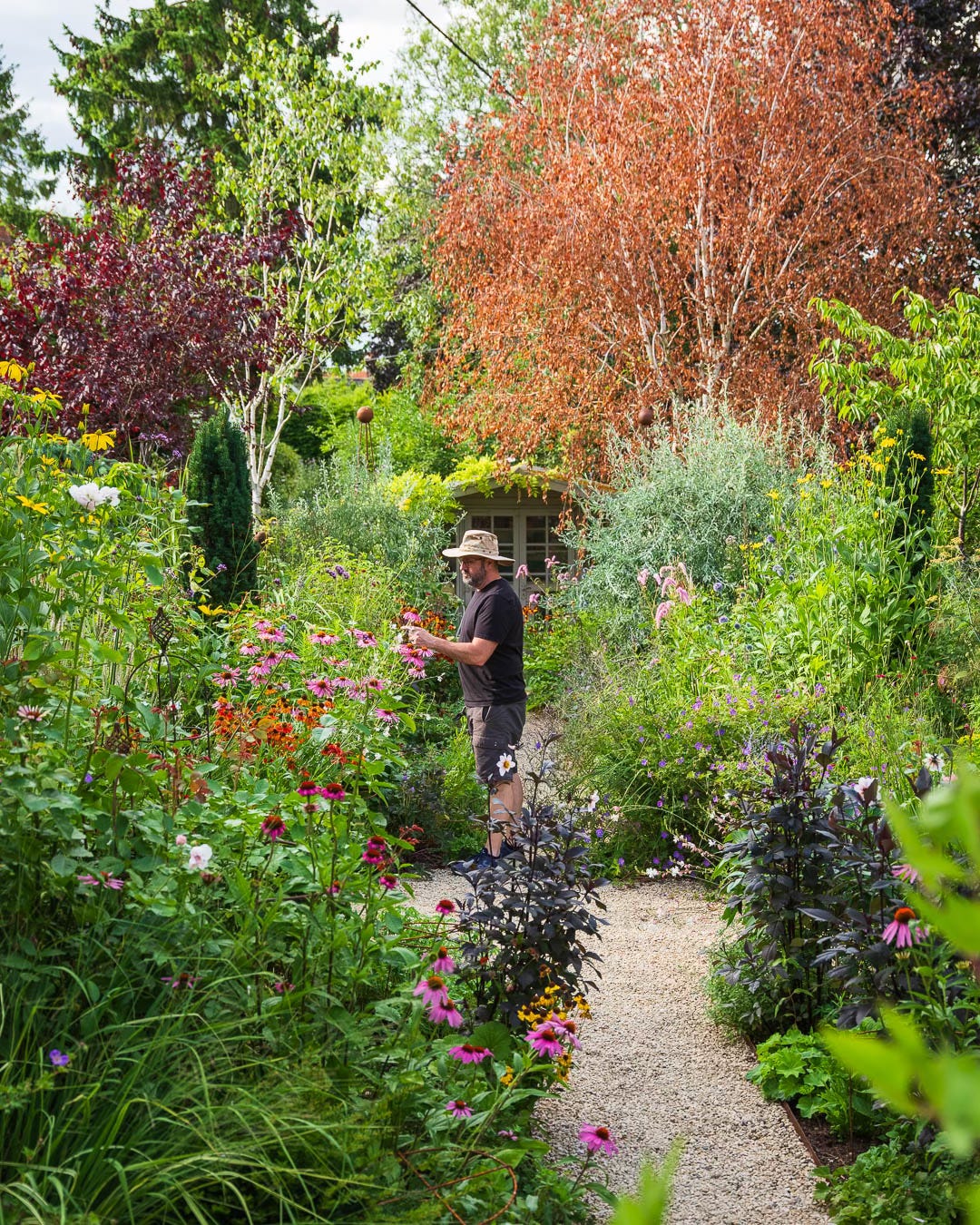

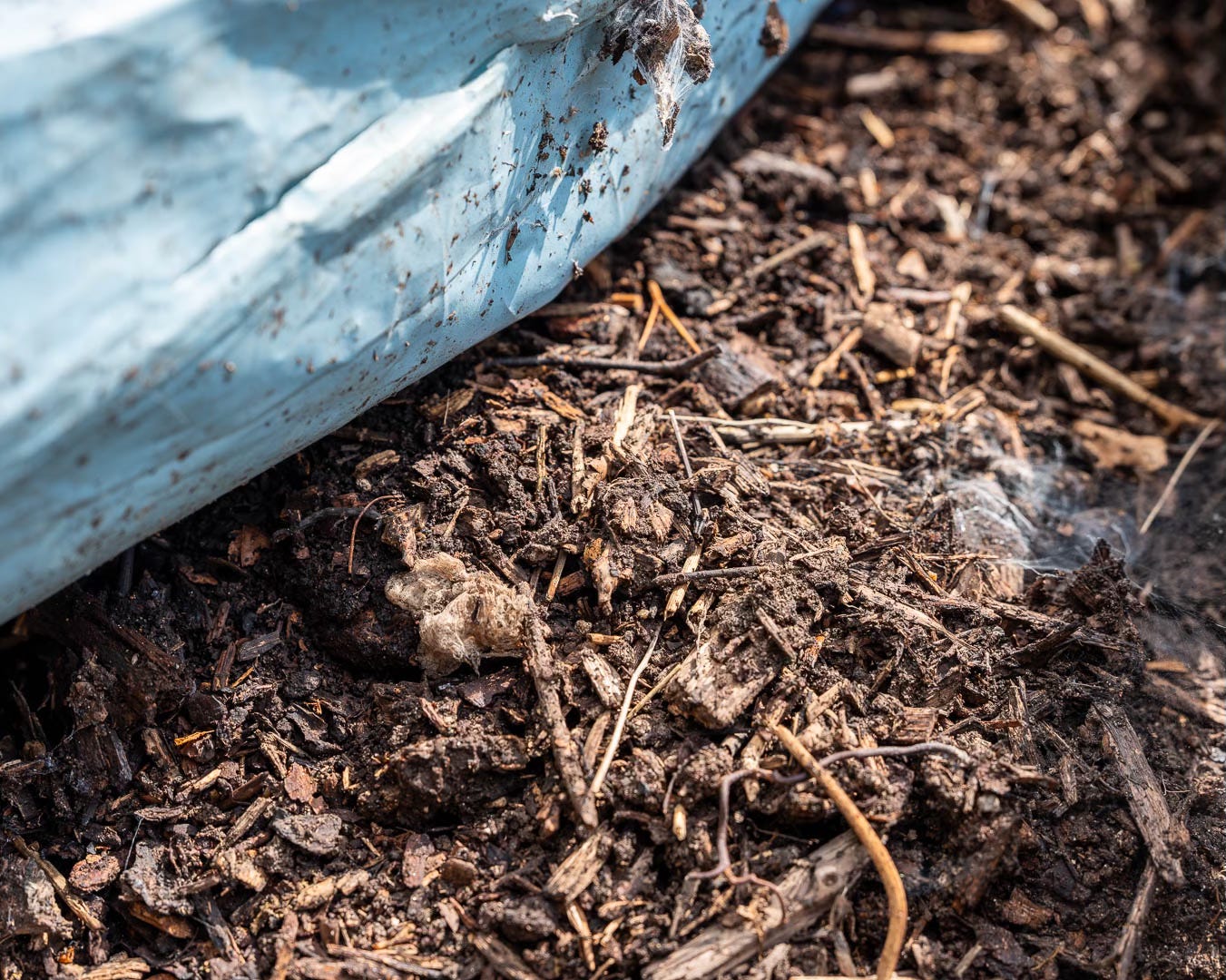


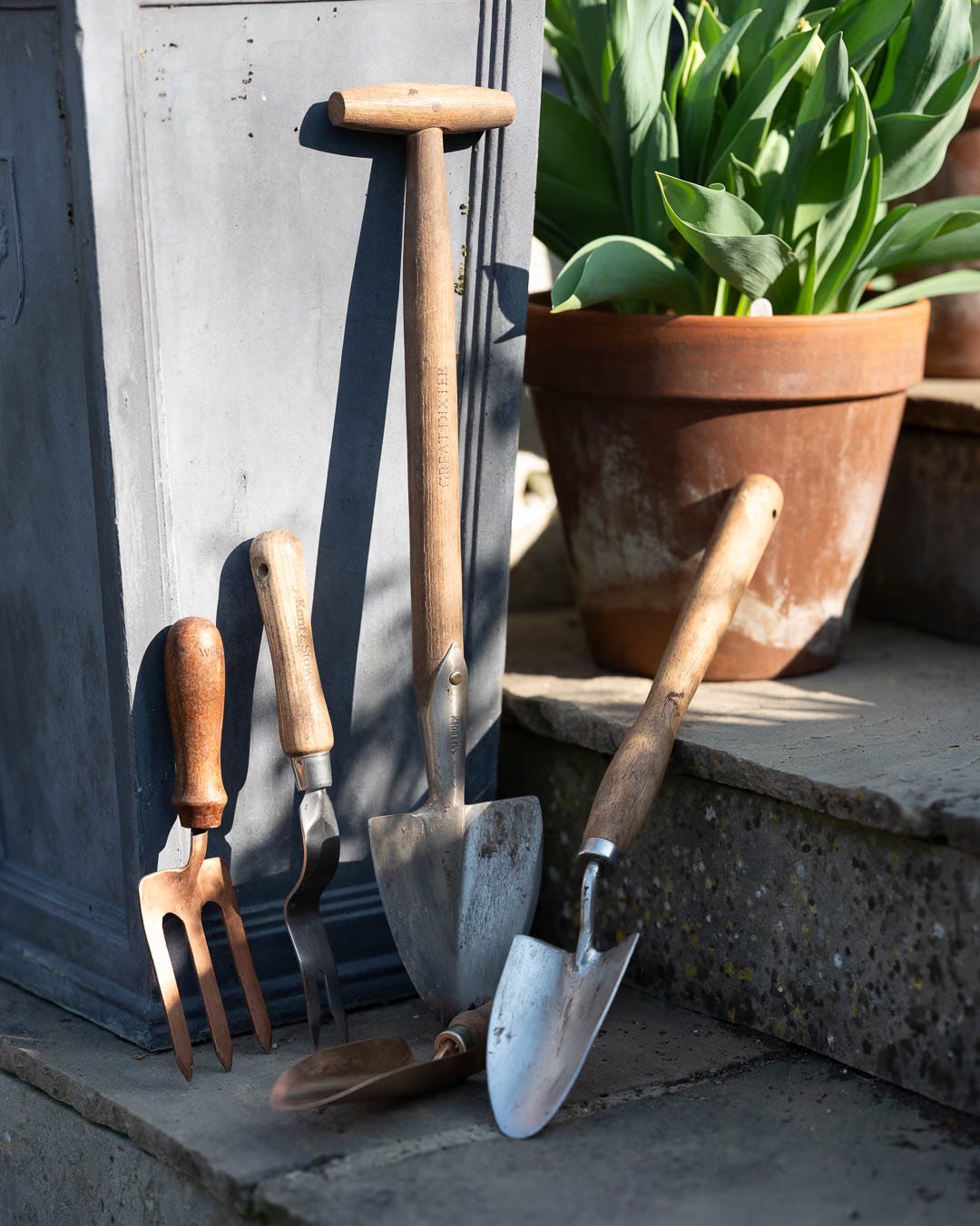

Thanks for a little glimpse into another gardeners' life. It's fun to see the similarities and the differences,
This article inspired me yesterday to get things done. We’re in a bit of a heat wave in the Seattle area. I couldn’t stand the thought of working outside in that. But reading this was just so peaceful . I got out in the early morning and had all my deadheading, supporting, weeding, and fertilizing done while it was lovely and cool. Thank you!